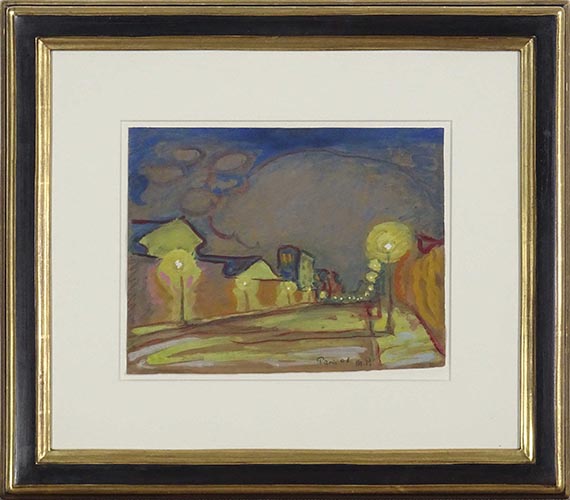368
Hermann Max Pechstein
Straße in Paris, 1908.
Tempera over pencil drawing
Estimate:
€ 20,000 / $ 23,600 Sold:
€ 53,340 / $ 62,941 (incl. surcharge)
Straße in Paris. 1908.
Tempera over pencil drawing.
Lower right monogrammed, dated and inscribed "Paris". On delicate brownish wove paper. 25 x 32.3 cm (9.8 x 12.7 in), the full sheet.
[AM].
• With a particularly captivating use of light and color.
• Pechstein lived in Paris from December 1907 until July 1908 - he rendered his impressions of the metropolis in this sheet.
• Similar works from Pechstein's early creative period are very rare on the international auction market (source: artprice.com).
Accompanied by a photo expertise (duplicate) from Max K. Pechstein, Hamburg, issued in July 1991.
PROVENANCE: Collection Ludwig Freund (1874-1935), Berlin/Mannheim (acquired around 1920).
Elisabeth Freund (1895-1962), neé Numrich (the above's wife, inherited).
Lotte Fanni (Charlotte) Heath, neé Freund (1918-2017, daughter of the above) and Georg Mostyn Heath (1914–2002), Herdfordshire (obtained from the above in 1950).
Private collection Rhineland.
EXHIBITION: 16th exhibition of the Berlin Secession: Zeichnende Künste, Berlin, 1908, cat. no. 904.
LITERATURE: Sotheby's Berlin, Auction 'Deutsche Kunst des 20. Jahrhunderts', November 28, 1991, lot 12.
"I traveled to Paris in December. Here I was also more attracted by the Cluny Museum and the Gothic sculptures of the cathedrals, Notre-Dame and Saint-Denisthe, than by the art of the nineteenth century. But what charmed me the most, even if I avoided mingling with painters and poets, was the life of the Seine city, its crowds [..]. On foot, I walked through the old Paris, with its air saturated with history. I looked at the beauty of the bridges and the panorama up to the lost palaces of the Ile-Saint-Louis. I don't need to mention that I visited all the art exhibitions, that I eagerly browsed the show windows of the bouquinists on the Quai.."
Hermann Max Pechstein on his stay in Paris 1907-08, quoted from: Jürgen Schilling, Max Pechstein. Zeichnungen und Aquarelle, ex. cat. Kunstverein Wolfsburg, October 4 - November 15, 1987, p. 10.
Tempera over pencil drawing.
Lower right monogrammed, dated and inscribed "Paris". On delicate brownish wove paper. 25 x 32.3 cm (9.8 x 12.7 in), the full sheet.
[AM].
• With a particularly captivating use of light and color.
• Pechstein lived in Paris from December 1907 until July 1908 - he rendered his impressions of the metropolis in this sheet.
• Similar works from Pechstein's early creative period are very rare on the international auction market (source: artprice.com).
Accompanied by a photo expertise (duplicate) from Max K. Pechstein, Hamburg, issued in July 1991.
PROVENANCE: Collection Ludwig Freund (1874-1935), Berlin/Mannheim (acquired around 1920).
Elisabeth Freund (1895-1962), neé Numrich (the above's wife, inherited).
Lotte Fanni (Charlotte) Heath, neé Freund (1918-2017, daughter of the above) and Georg Mostyn Heath (1914–2002), Herdfordshire (obtained from the above in 1950).
Private collection Rhineland.
EXHIBITION: 16th exhibition of the Berlin Secession: Zeichnende Künste, Berlin, 1908, cat. no. 904.
LITERATURE: Sotheby's Berlin, Auction 'Deutsche Kunst des 20. Jahrhunderts', November 28, 1991, lot 12.
"I traveled to Paris in December. Here I was also more attracted by the Cluny Museum and the Gothic sculptures of the cathedrals, Notre-Dame and Saint-Denisthe, than by the art of the nineteenth century. But what charmed me the most, even if I avoided mingling with painters and poets, was the life of the Seine city, its crowds [..]. On foot, I walked through the old Paris, with its air saturated with history. I looked at the beauty of the bridges and the panorama up to the lost palaces of the Ile-Saint-Louis. I don't need to mention that I visited all the art exhibitions, that I eagerly browsed the show windows of the bouquinists on the Quai.."
Hermann Max Pechstein on his stay in Paris 1907-08, quoted from: Jürgen Schilling, Max Pechstein. Zeichnungen und Aquarelle, ex. cat. Kunstverein Wolfsburg, October 4 - November 15, 1987, p. 10.
368
Hermann Max Pechstein
Straße in Paris, 1908.
Tempera over pencil drawing
Estimate:
€ 20,000 / $ 23,600 Sold:
€ 53,340 / $ 62,941 (incl. surcharge)
Headquarters
Joseph-Wild-Str. 18
81829 Munich
Phone: +49 89 55 244-0
Fax: +49 89 55 244-177
info@kettererkunst.de
Louisa von Saucken / Undine Schleifer
Holstenwall 5
20355 Hamburg
Phone: +49 40 37 49 61-0
Fax: +49 40 37 49 61-66
infohamburg@kettererkunst.de
Dr. Simone Wiechers / Nane Schlage
Fasanenstr. 70
10719 Berlin
Phone: +49 30 88 67 53-63
Fax: +49 30 88 67 56-43
infoberlin@kettererkunst.de
Cordula Lichtenberg
Gertrudenstraße 24-28
50667 Cologne
Phone: +49 221 510 908-15
infokoeln@kettererkunst.de
Hessen
Rhineland-Palatinate
Miriam Heß
Phone: +49 62 21 58 80-038
Fax: +49 62 21 58 80-595
infoheidelberg@kettererkunst.de
We will inform you in time.




 Lot 368
Lot 368 

